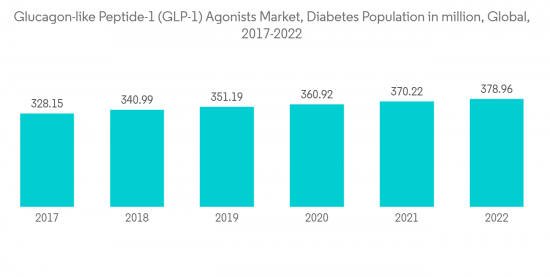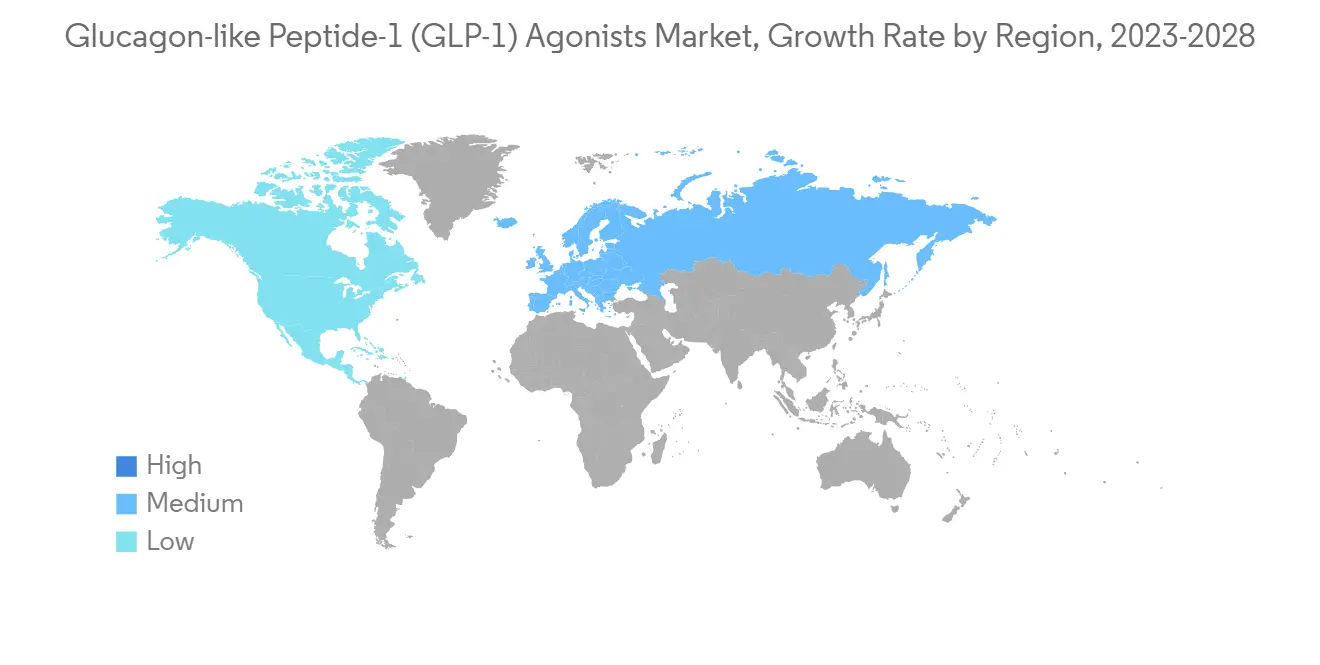 |
市場調査レポート
商品コード
1331248
グルカゴン様ペプチド-1(GLP-1)作動薬の市場規模・シェア分析- 成長動向と予測(2023年~2028年)Glucagon-Like Peptide-1 (GLP-1) Agonists Market Size & Share Analysis - Growth Trends & Forecasts (2023 - 2028) |
||||||
● お客様のご希望に応じて、既存データの加工や未掲載情報(例:国別セグメント)の追加などの対応が可能です。 詳細はお問い合わせください。
| グルカゴン様ペプチド-1(GLP-1)作動薬の市場規模・シェア分析- 成長動向と予測(2023年~2028年) |
|
出版日: 2023年08月08日
発行: Mordor Intelligence
ページ情報: 英文 110 Pages
納期: 2~3営業日
|
- 全表示
- 概要
- 目次
グルカゴン様ペプチド-1(GLP-1)作動薬の市場規模は2023年に118億7,000万米ドルと推定され、2028年には125億5,000万米ドルに達すると予測され、予測期間中(2023-2028年)のCAGRは1.12%で成長する見込みです。
2027年には約130億米ドルに達すると推定されます。
COVID-19パンデミックはグルカゴン様ペプチド-1(GLP-1)作動薬市場にプラスの影響を与えました。糖尿病とコントロールされていない高血糖は、COVID-19患者の予後を悪化させる危険因子であり、重症化や死亡のリスクを高める。糖尿病患者は免疫系が弱く、COVID-19合併症が病状を悪化させ、免疫系は急速に弱くなります。糖尿病の人は普通の人よりもむしろ重篤な合併症に陥る可能性が高いです。
グルカゴン様ペプチド-1受容体作動薬(GLP-1RA)は、2型糖尿病の治療に使われる薬の一種であり、一部の薬は肥満症にも承認されています。スルホニル尿素薬やメグリチニド薬などの旧来のインスリン分泌促進薬と比較して、このクラスの薬剤の利点の1つは、低血糖を引き起こすリスクが低いことです。重要なグルコース低下薬であることに加え、GLP-1RAには重要な抗炎症作用と肺保護作用があり、腸内微生物の構成に有利な影響を与えます。したがって、GLP-1RAは、2型糖尿病の有無にかかわらず、COVID-19感染に罹患した患者を治療するための潜在的な候補であり、COVID-19の流行期には優れた抗糖尿病薬(グルコース低下薬)となります。
国際糖尿病連合(IDF)によると、2021年の成人糖尿病人口は約5億3,700万人で、2030年には6億4,300万人増加します。技術の進歩は、GLP-1RA製剤や開発中の製剤にいくつかの改良を加えることにつながっています。
したがって、前述の要因によって、この市場は分析期間中に成長すると予想されます。
グルカゴン様ペプチド-1(GLP-1)作動薬市場動向
今年度のグルカゴン様ペプチド-1(GLP-1)作動薬市場ではデュラグルチド製剤が最も高い市場シェアを占める
今年度のグルカゴン様ペプチド-1(GLP-1)作動薬市場において、デュラグルチド製剤が約45.8%の高シェアを占めました。
国際糖尿病連合(IDF)によると、2021年の成人糖尿病人口は約5億3,700万人で、2030年には6億4,300万人に増加します。GLP-1RA薬剤や開発中の製剤のいくつかの改良につながる技術の進歩は、この期間中に増加しました。
GLP1RA製剤は国際的に入手可能であり、メトホルミンと生活習慣の管理後に2型糖尿病の治療増量が必要な場合に使用することが推奨されています。GLP1RAは、ビルダグリプチンを除くすべての血糖降下薬と安全に併用することができます。デュラグルチド(Trulicity)は週1回皮下投与のGLP1RAであり、HbA1cを低下させ、さらに体重減少および心筋保護効果をもたらします。デュラグルチドによる治療により、多くの患者はインスリンおよび/またはスルホニル尿素薬を使用せずに目標HbA1cに到達し、維持することが可能となり、それに伴う低血糖リスクがなくなります。GLP1RAはより大きな体重減少をもたらし、心不全や腎疾患以外の脳血管疾患が優勢な場合にはSLGT2阻害薬よりも推奨されます。
デュラグルチドは、一部の国では特別な権限を有する基準を満たす患者に対して全額助成されています。例えば、ニュージーランドのガイドラインでは、HbA1c値が目標値を超えているすべての患者にGLP1RAを投与することを推奨しており、特にGLP1RAを使用することで心血管リスクがさらに低下し、かつ/または体重増加や低血糖の原因となる他の治療法の減量や中止が可能となる場合に推奨されています。
肥満率の上昇、2型糖尿病の遺伝的要因の増加、有病率の上昇および政府による支援策により、市場は今後も成長を続けると思われます。

グルカゴン様ペプチド-1(GLP-1)作動薬市場は北米地域が最も高いシェアを占める
北米は、今年度のグルカゴン様ペプチド-1(GLP-1)作動薬市場において、約62.6%の最高市場シェアを占めました。
米国疾病予防管理センター(CDC)の全国糖尿病統計報告書2022年版によると、米国では1億3,000万人以上の成人が糖尿病または糖尿病予備軍であると推定されています。2型糖尿病は、有色人種、地方在住者、教育水準が低く、所得が低く、ヘルスリテラシーが低い人々の間でより一般的であり、糖尿病はより深刻です。
カナダ保健省は、GLP-1作動薬に関心を持つ人々により多くの選択肢を提供する3番目の規制当局です。カナダ保健省は、欧州医薬品庁と米国での承認に続き、最近、2型糖尿病患者を対象とした最初で唯一のGLP-1作動薬(ノボ・ノルディスクのRybelsus)を承認しました。GLP-1 RAは、単独または他の2型糖尿病治療薬と併用することで、血糖管理、すなわち範囲内の時間を改善することができます。GLP-1RAは血糖値を下げるだけでなく、心臓発作、脳卒中、心臓関連死のリスクを低下させ、心臓の健康にも役立ちます。2型糖尿病患者は糖尿病のない患者に比べて心臓病のリスクがかなり高いので、これは重要です。
座りがちなライフスタイルによる糖尿病の有病率の高さと上記の要因から、市場は予測期間中に成長すると予想されます。

グルカゴン様ペプチド-1(GLP-1)作動薬業界概要
GLP-1市場は統合されており、Eli Lilly、Sanofi、Novo Nordisk、AstraZenecaなどの主要メーカーが全地域で存在感を示しています。
その他の特典
- エクセル形式の市場予測(ME)シート
- 3ヶ月間のアナリスト・サポート
目次
第1章 イントロダクション
- 調査の前提と市場定義
- 調査範囲
第2章 調査手法
第3章 エグゼクティブサマリー
第4章 市場力学
- 市場概要
- 市場促進要因
- 市場抑制要因
- ポーターのファイブフォース分析
- 供給企業の交渉力
- 消費者の交渉力
- 新規参入業者の脅威
- 代替品の脅威
- 競争企業間の敵対関係の強さ
第5章 市場セグメンテーション
- 医薬品
- デュラグルチド
- トルリシティ
- エクセナチド
- バイエッタ
- ビデュロン
- リラグルチド
- ビクトーザ
- リキセナチド
- リキスミア
- セマグルチド
- オゼンピック
- デュラグルチド
- 地域
- 北米
- 米国
- カナダ
- 北米以外
- 欧州
- ドイツ
- スペイン
- イタリア
- フランス
- 英国
- ロシア
- その他欧州
- アジア太平洋
- 日本
- 中国
- オーストラリア
- インド
- 韓国
- マレーシア
- インドネシア
- タイ
- フィリピン
- その他アジア太平洋地域
- ラテンアメリカ
- ブラジル
- メキシコ
- その他ラテンアメリカ
- 中東・アフリカ
- 南アフリカ
- サウジアラビア
- オマーン
- エジプト
- イラン
- その他中東とアフリカ
- 北米
第6章 市場指標
- 1型糖尿病人口
- 2型糖尿病人口
第7章 競合情勢
- 企業プロファイル
- Novo Nordisk
- Sanofi
- Eli Lilly
- AstraZeneca
- Boehringer Ingelheim
- Pfizer
- 市場シェア分析
- NovoNordisk
- Sanofi
- AstraZeneca
- Others
第8章 市場機会と将来動向
The Glucagon-like Peptide-1 (GLP-1) Agonists Market size is estimated at USD 11.87 billion in 2023, and is expected to reach USD 12.55 billion by 2028, growing at a CAGR of 1.12% during the forecast period (2023-2028).
The market is estimated to reach a value of about USD 13 billion by 2027.
The COVID-19 pandemic positively impacted the Glucagon-like Peptide-1 (GLP-1) Agonists Market. Diabetes and uncontrolled hyperglycemia are risk factors for poor outcomes in patients with COVID-19 including an increased risk of severe illness or death. People with diabetes have a weaker immune system, the COVID-19 complication aggravates the condition, and the immune system gets weaker very fast. People with diabetes have more chances to get into serious complications rather than normal people.
Glucagon-like peptide-1 receptor agonists (GLP-1RAs) are a class of medications used for the treatment of type 2 diabetes and some drugs are also approved for obesity. One of the benefits of this class of drugs over older insulin secretagogues, such as sulfonylureas or meglitinides, is that they have a lower risk of causing hypoglycemia. Besides being important glucose-lowering agents, GLP-1RAs have significant anti-inflammatory and pulmonary protective effects and an advantageous impact on gut microbes' composition. Therefore, GLP-1RAs have been potential candidates for treating patients affected by COVID-19 infection, with or even without type 2 diabetes, as well as excellent antidiabetic (glucose-lowering) agents during COVID-19 pandemic times.
According to International Diabetes Federation (IDF), the adult diabetes population in 2021 is approximately 537 million, and this number is going to increase by 643 million in 2030. Technological advancements have increased over the period leading to several modifications either in the GLP-1RA drug or the formulations being developed.
Therefore, owing to the aforementioned factors the studied market is anticipated to witness growth over the analysis period.
Glucagon-like Peptide-1 (GLP-1) Agonists Market Trends
Dulaglutide Segment Occupied the Highest Market Share in the Glucagon-like Peptide-1 (GLP-1) Agonists Market in the current year
Dulaglutide drug held the highest share of about 45.8% in the Glucagon-like Peptide-1 (GLP-1) Agonists Market in the current year.
According to International Diabetes Federation (IDF), the adult diabetes population in 2021 was approximately 537 million, which will increase by 643 million in 2030. Technological advancements increased over the period leading to several modifications in the GLP-1RA drug or the formulations being developed.
GLP1RAs are available internationally and are recommended for use when treatment escalation for type 2 diabetes is required after metformin and lifestyle management. They can be safely used with all other glucose-lowering therapies except vildagliptin. Dulaglutide (Trulicity) is a weekly subcutaneous GLP1RA that reduces HbA1c with additional weight loss and cardiorenal protection benefits. Therapy with dulaglutide allows many patients to reach and maintain target HbA1c without insulin and/or sulfonylureas, eliminating the associated hypoglycemia risk. GLP1RAs elicit greater weight reduction and are recommended over SLGT2 inhibitors when cerebrovascular disease other than heart failure or renal disease predominates.
Dulaglutide is fully funded for patients meeting special authority criteria in some countries. For instance, New Zealand guidelines recommend offering GLP1RAs to all patients with HbA1c levels above target, especially when GLP1RA use would provide additional reductions in cardiovascular risk and/or permit reduction or cessation of other therapies that contribute to weight gain or hypoglycemia.
Owing to the rising rate of obesity, growing genetic factors for type-2 diabetes, and the increasing prevalence and government support initiatives, the market will likely continue to grow.

North American region held the highest market share in the Glucagon-like Peptide-1 (GLP-1) Agonists Market in the current year
North America held the highest market share of about 62.6% in the Glucagon-like Peptide-1 (GLP-1) Agonists Market in the current year.
The Centers for Disease Control and Prevention (CDC) National Diabetes Statistics Report 2022 estimated that more than 130 million adults are living with diabetes or prediabetes in the United States. Type 2 diabetes is more common, and diabetes is more consequential among communities of color, those who live in rural areas, and those with less education, lower incomes, and lower health literacy.
Health Canada is the third regulatory agency to provide more options for people interested in GLP-1 agonists. It approved the first and only GLP-1 agonist pill (Rybelsus by Novo Nordisk) for people with type 2 diabetes recently after approval by the European Medicines Agency and the US. GLP-1 RAs can be taken alone or in combination with other treatments for type 2 diabetes to improve blood glucose management, i.e., time in range. In addition to lowering blood glucose, they benefit heart health by reducing the risk of heart attack, stroke, and heart-related death. It is important because people with type 2 diabetes are at substantially higher risk of heart disease than those without diabetes.
Owing to the high prevalence of diabetes due to a sedentary lifestyle and the factors above market is expected to grow over the forecast period.

Glucagon-like Peptide-1 (GLP-1) Agonists Industry Overview
The GLP-1 market is consolidated, with major manufacturers, namely Eli Lilly, Sanofi, Novo Nordisk, AstraZeneca, etc., holding a presence in all regions.
Additional Benefits:
- The market estimate (ME) sheet in Excel format
- 3 months of analyst support
TABLE OF CONTENTS
1 INTRODUCTION
- 1.1 Study Assumptions and Market Definition
- 1.2 Scope of the Study
2 RESEARCH METHODOLOGY
3 EXECUTIVE SUMMARY
4 MARKET DYNAMICS
- 4.1 Market Overview
- 4.2 Market Drivers
- 4.3 Market Restraints
- 4.4 Porter's Five Forces Analysis
- 4.4.1 Bargaining Power of Suppliers
- 4.4.2 Bargaining Power of Consumers
- 4.4.3 Threat of New Entrants
- 4.4.4 Threat of Substitute Products and Services
- 4.4.5 Intensity of Competitive Rivalry
5 MARKET SEGMENTATION
- 5.1 Drugs
- 5.1.1 Dulaglutide
- 5.1.1.1 Trulicity
- 5.1.2 Exenatide
- 5.1.2.1 Byetta
- 5.1.2.2 Bydureon
- 5.1.3 Liraglutide
- 5.1.3.1 Victoza
- 5.1.4 Lixisenatide
- 5.1.4.1 Lyxumia
- 5.1.5 Semaglutide
- 5.1.5.1 Ozempic
- 5.1.1 Dulaglutide
- 5.2 Geography
- 5.2.1 North America
- 5.2.1.1 United States
- 5.2.1.2 Canada
- 5.2.1.3 Rest of North America
- 5.2.2 Europe
- 5.2.2.1 Germany
- 5.2.2.2 Spain
- 5.2.2.3 Italy
- 5.2.2.4 France
- 5.2.2.5 United Kingdom
- 5.2.2.6 Russia
- 5.2.2.7 Rest of Europe
- 5.2.3 Asia-Pacific
- 5.2.3.1 Japan
- 5.2.3.2 China
- 5.2.3.3 Australia
- 5.2.3.4 India
- 5.2.3.5 South Korea
- 5.2.3.6 Malaysia
- 5.2.3.7 Indonesia
- 5.2.3.8 Thailand
- 5.2.3.9 Philippines
- 5.2.3.10 Rest of Asia-Pacific
- 5.2.4 Latin America
- 5.2.4.1 Brazil
- 5.2.4.2 Mexico
- 5.2.4.3 Rest of Latin America
- 5.2.5 Middle East and Africa
- 5.2.5.1 South Africa
- 5.2.5.2 Saudi Arabia
- 5.2.5.3 Oman
- 5.2.5.4 Egypt
- 5.2.5.5 Iran
- 5.2.5.6 Rest of Middle East and Africa
- 5.2.1 North America
6 MARKET INDICATORS
- 6.1 Type-1 Diabetes Population
- 6.2 Type-2 Diabetes Population
7 COMPETITIVE LANDSCAPE
- 7.1 COMPANY PROFILES
- 7.1.1 Novo Nordisk
- 7.1.2 Sanofi
- 7.1.3 Eli Lilly
- 7.1.4 AstraZeneca
- 7.1.5 Boehringer Ingelheim
- 7.1.6 Pfizer
- 7.2 MARKET SHARE ANALYSIS
- 7.2.1 NovoNordisk
- 7.2.2 Sanofi
- 7.2.3 AstraZeneca
- 7.2.4 Others
